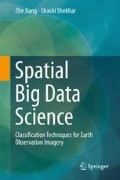Abstract
This chapter introduces a novel ensemble learning framework called spatial ensemble, which is used to classify heterogeneous spatial data with class ambiguity. Class ambiguity refers to the phenomenon whereby samples with similar features belong to different classes at different locations (e.g., spectral confusion between different thematic classes in earth observation imagery). This chapter also provides preliminary results of comparison between spatial ensemble and traditional ensemble learning (e.g., bagging, boosting, and random forest) on wetland mapping datasets.
Access this chapter
Tax calculation will be finalised at checkout
Purchases are for personal use only
References
T.K. Ho, M. Basu, Complexity measures of supervised classification problems. IEEE Trans. Pattern Anal. Mach. Intel. 24(3), 289–300 (2002)
T.K. Ho, M. Basu, M.H.C. Law, Measures of geometrical complexity in classification problems, in Data Complexity in Pattern Recognition (Springer, 2006), pp. 1–23
A.S. Fotheringham, C. Brunsdon, M. Charlton, in Geographically Weighted Regression: The Analysis of Spatially Varying Relationships (Wiley, 2003)
B. Pease, A. Pease, in The Definitive Book of Body Language (Bantam, 2006)
T.G. Dietterich, Ensemble methods in machine learning, in Multiple Classifier Systems (Springer, 2000), pp. 1–15
Z.-H. Zhou, Ensemble Methods: Foundations and Algorithms (CRC Press, 2012)
Y. Ren, L. Zhang, P. Suganthan, Ensemble classification and regression-recent developments, applications and future directions [review article]. Comput. Intel. Mag. IEEE 11(1), 41–53 (2016)
L. Breiman, Bagging predictors. Mach. Learn. 24(2), 123–140 (1996)
Y. Freund, R.E. Schapire, A decision-theoretic generalization of on-line learning and an application to boosting. J. Comput. Syst. Sci. 55(1), 119–139 (1997)
L. Breiman, Random forests. Mach. Learn. 45(1), 5–32 (2001)
R.A. Jacobs, M.I. Jordan, S.J. Nowlan, G.E. Hinton, Adaptive mixtures of local experts. Neural Comput. 3(1), 79–87 (1991)
S.E. Yuksel, J.N. Wilson, P.D. Gader, Twenty years of mixture of experts. IEEE Trans. Neural Netw. Learn. Syst. 23(8), 1177–1193 (2012)
A. Karpatne, A. Khandelwal, V. Kumar, Ensemble learning methods for binary classification with multi-modality within the classes, in Proceedings of the 2015 SIAM International Conference on Data Mining, Vancouver, BC, Canada, April 30 - May 2, 2015 (SIAM, 2015), pp. 730–738
L. Xu, M.I. Jordan, G.E. Hinton, An alternative model for mixtures of experts, in Advances in Neural Information Processing Systems (1995), pp. 633–640
V. Ramamurti, J. Ghosh, Advances in using hierarchical mixture of experts for signal classification, in 1996 IEEE International Conference on Acoustics, Speech, and Signal Processing, 1996. ICASSP-96. Conference Proceedings, vol. 6 (IEEE, 1996), pp. 3569–3572
G. Jun, J. Ghosh, Semisupervised learning of hyperspectral data with unknown land-cover classes. IEEE Trans. Geosci. Rem. Sens. 51(1), 273–282 (2013)
A.R. Gonçalves, F.J. Von Zuben, A. Banerjee, Multi-label structure learning with ising model selection, in Proceedings of the 24th International Conference on Artificial Intelligence (AAAI Press, 2015), pp. 3525–3531
M. Szummer, R.W. Picard, Indoor-outdoor image classification, in Proceedings of the 1998 IEEE International Workshop on Content-Based Access of Image and Video Database, 1998 (IEEE, 1998), pp. 42–51
Z. Jiang, S. Shekhar, A. Kamzin, J. Knight, Learning a spatial ensemble of classifiers for raster classification: A summary of results, in 2014 IEEE International Conference on Data Mining Workshop (ICDMW) (IEEE, 2014), pp. 15–18
M. Fauvel, Y. Tarabalka, J.A. Benediktsson, J. Chanussot, J.C. Tilton, Advances in spectral-spatial classification of hyperspectral images. Proc. IEEE 101(3), 652–675 (2013)
D. Lu, Q. Weng, A survey of image classification methods and techniques for improving classification performance. Int. J. Rem. Sens. 28(5), 823–870 (2007)
J. Dong, W. Xia, Q. Chen, J. Feng, Z. Huang, S. Yan, Subcategory-aware object classification, in Proceedings of the IEEE Conference on Computer Vision and Pattern Recognition (2013), pp. 827–834
W.R. Tobler, A computer movie simulating urban growth in the detroit region. Econ. Geogr. 46, 234–240 (1970)
R.M. Haralick, L.G. Shapiro, Image segmentation techniques, in 1985 Technical Symposium East. International Society for Optics and Photonics (1985), pp. 2–9
Weka 3: Data mining software in java (2016), http://www.cs.waikato.ac.nz/ml/weka/
D.R. Martin, C.C. Fowlkes, Matlab codes for multi-class hierarchical mixture of experts model (2002), http://www.ics.uci.edu/~fowlkes/software/hme/
L.P. Rampi, J.F. Knight, K.C. Pelletier, Wetland mapping in the upper midwest united states. Photogram. Eng. Rem. Sens. 80(5), 439–448 (2014)
Author information
Authors and Affiliations
Corresponding author
Rights and permissions
Copyright information
© 2017 Springer International Publishing AG
About this chapter
Cite this chapter
Jiang, Z., Shekhar, S. (2017). Spatial Ensemble Learning. In: Spatial Big Data Science. Springer, Cham. https://doi.org/10.1007/978-3-319-60195-3_6
Download citation
DOI: https://doi.org/10.1007/978-3-319-60195-3_6
Published:
Publisher Name: Springer, Cham
Print ISBN: 978-3-319-60194-6
Online ISBN: 978-3-319-60195-3
eBook Packages: Computer ScienceComputer Science (R0)

